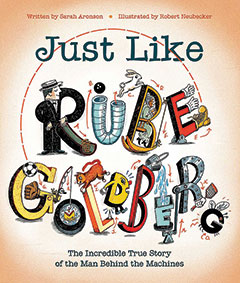 You would think that being friends with Tanya Lee Stone would mean I wrote lots of nonfiction. But the truth is, until I decided to try and write a biography of Rube Goldberg, I stayed far away from this genre. As a reader, I loved it. As a friend, I learned so much reading Tanya’s work — not just about the facts — but about the foundations of storytelling. But I was hesitant to dive in. Maybe it was the research she had to do. Maybe I lacked confidence. But when I began my challenge to “write what I didn’t think I was good at,” (a challenge made to decrease my own perfectionist tendencies and expectations), I found myself enjoying every aspect of this craft.
You would think that being friends with Tanya Lee Stone would mean I wrote lots of nonfiction. But the truth is, until I decided to try and write a biography of Rube Goldberg, I stayed far away from this genre. As a reader, I loved it. As a friend, I learned so much reading Tanya’s work — not just about the facts — but about the foundations of storytelling. But I was hesitant to dive in. Maybe it was the research she had to do. Maybe I lacked confidence. But when I began my challenge to “write what I didn’t think I was good at,” (a challenge made to decrease my own perfectionist tendencies and expectations), I found myself enjoying every aspect of this craft.
If you are also interested in writing something true — as in nonfiction true — here are some things I learned writing Just Like Rube Goldberg, my first picture book biography!
- You need to read carefully. This may seem obvious, but as a fiction reader, I was used to inferring from the text. When you are reading to discover your true story, don’t skim! Don’t infer! Take careful notes. It’s not like reading a novel. It’s like going deep sea diving for something precious. As you read sources, you are looking for TRUTH. Don’t forget to keep a list of your sources. And every fact needs to be confirmed in multiple places. When I think about it, it’s not that different from creating a character in a novel. I have to get to the heart of the person — the element that will connect that person to the reader. But in this case, it has to be true!
- Just like in fiction, your theme or through-line will appear. The more you get to know your subject, the clearer THE WHY will become. If you have a hunch about a person, time, or place, follow that hunch! Keep reading! Look for the glimmer that offers a foundation and structure to tell the story.
- It’s fun. This was perhaps the biggest surprise! I actually like research a lot. I loved going to the library. I loved talking to people about Rube. I also find myself looking for stories with new enthusiasm. True stories are inspiring! They are sometimes whackier than fiction!
- Editors and copy editors are your best friends! (Well, I actually knew that already, but I can’t leave them out of this post!) When you start finding your voice, you need your team to tell you when you have taken a liberty. For me, writing this book almost became a Rube Goldberg machine! But as my editor pushed me, I also found new facts that made the story even stronger!
- Your voice is the glimmer! Your voice is what will invite readers into your true story. Your point of view will offer your readers the truth in a way that engages them and makes them want to read and learn more!
Writers, even though I am interested in all kinds of topics, I stayed away from nonfiction for a really long time. Well, not anymore! Perhaps the best benefit to trying nonfiction is that it gave me a new way to use my brain and play with creativity. It gave me more energy for my novel. It sparked new inspiration for other picture books that had been in the drawer for a long time. Best of all, inspiration comes in all sorts of ways. I am getting ready to submit a story that came from researching another story! Remember: writing and all its parts, including discovery, is a practice! Writing nonfiction has given me more stamina for all my stories!
